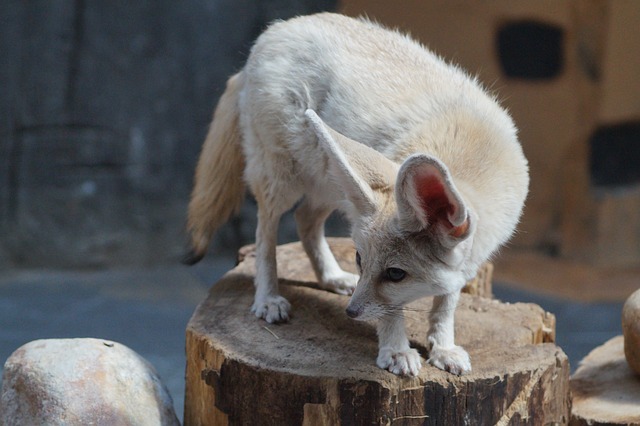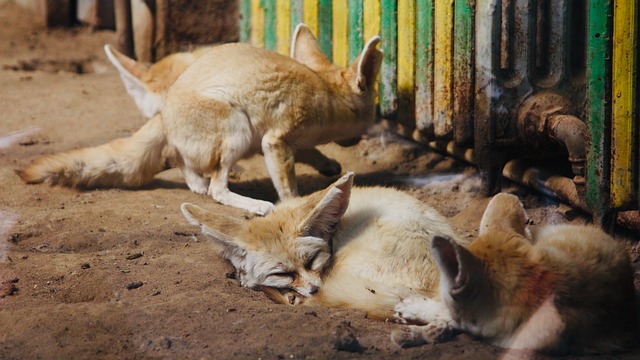The fennec fox (Vulpes zerda) is a small crepuscular fox native to the deserts of North Africa, ranging from Western Sahara and Mauritania to the Sinai Peninsula. Its most distinctive feature is its unusually large ears, which serve to dissipate heat and listen for underground prey
Here are some interesting facts about fennec foxes
Facts
Diet: They are omnivorous and primarily feed on a diet of insects, small mammals, birds, eggs, and desert vegetation.
Lifespan: In captivity, Fennec foxes can live up to 14 to 15 years, while their lifespan in the wild is generally shorter.
Camouflage: Their pale yellow to cream-colored fur helps them blend into their desert surroundings.
Social Behavior: Fennec foxes are generally social animals and often live in family groups called “troops.”
Burrow Dwellers: They dig extensive burrows for shelter, which can include multiple entrances and chambers.
Reproduction: Breeding typically occurs once a year, with a gestation period of around 50 to 52 days.
Litter Size: Fennec foxes usually give birth to litters of 2 to 5 pups.

Parental Care: Both parents participate in caring for and feeding the pups.
Vocalizations: They communicate using a range of vocalizations, including barking, purring, and chirping sounds.
Territorial Behavior: Fennec foxes mark their territories with urine and feces.
Range: Their range extends across parts of North Africa, including Algeria, Morocco, Tunisia, Libya, and Egypt.
Climbing Abilities: They are skilled climbers and can navigate rocky terrain and dunes.
Speed and Agility: Fennec foxes are agile and can move quickly through their desert habitat.
Tail: Their long, bushy tails help with balance and serve as protection against the desert sun.
Conservation Status: Fennec foxes are listed as a species of “Least Concern” by the International Union for Conservation of Nature (IUCN).
Predators: Their main predators in the wild include larger desert carnivores, such as jackals, owls, and eagles.
Burrow Complexes: Fennec foxes may have interconnected burrows, allowing them to move between chambers and entrances.
Burrowing as a Cool Shelter: They use their burrows to escape the extreme heat of the desert during the day.
Hydration Source: Fennec foxes can obtain some of their water needs from the food they eat.
Solitary Hunters: While they live in social groups, they often hunt individually.
Population Declines: Human activity, habitat loss, and the illegal pet trade have led to declines in Fennec fox populations.
Temperature Regulation: Their large ears help regulate their body temperature by dissipating heat.
Night Vision: Fennec foxes have excellent night vision, which is crucial for their nocturnal hunting.
Reproductive Cycles: Breeding in Fennec foxes is often triggered by the availability of food resources.
Quick Reflexes: Their quick reflexes and keen senses make them effective hunters in the dark.
Burrowing Adaptations: They use their powerful claws to dig burrows, which can extend several feet underground.

Sand-Resistant Eyes: They have a specialized membrane over their eyes that helps protect against sand and dust.
Ears as Radiators: The large surface area of their ears helps release excess body heat.
Unique Dentition: Fennec foxes have sharp teeth adapted for hunting and eating a variety of prey.
Barking Communication: They often bark to communicate with each other within a group.
Temperature Extremes: Fennec foxes can endure temperature extremes, from below freezing at night to scorching daytime heat.
Desert Flora Diet: In addition to insects and small animals, they may consume desert plants and fruits for hydration.
Well-Hydrated Prey: They often prey on insects like locusts, which have a high water content.
Color Variation: Fur color can vary slightly among individuals, but it generally matches the sand and rock colors of the desert.
Circular Burrow Entrances: Their burrow entrances are often circular, which helps prevent sand from collapsing into the tunnel.
Sensory Whiskers: They have whiskers on their muzzles to help them navigate in the dark.
Threatened by Habitat Loss: Desertification and human development threaten their habitat.
Desert Subspecies: There are several subspecies of Fennec foxes found in different regions of North Africa.
High Population Density: In some areas, Fennec fox populations can be quite dense, with multiple burrows per square kilometer.
Limited Domestication: Despite their small size and appealing appearance, Fennec foxes are not widely domesticated due to their specialized care requirements.
Caching Food: They may cache excess food in their burrows for future consumption.
Cultural Significance: Fennec foxes have cultural significance in some North African and Middle Eastern societies.
